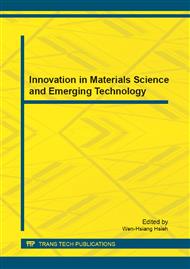p.109
p.114
p.119
p.124
p.129
p.134
p.138
p.143
p.149
Numerical and Experimental Investigations on Heat Transfer Phenomena of an Aluminium Microchannel Heat Sink
Abstract:
The study was done both numerically and experimentally on the heat transfer behaviors of a microchannel heat sink. The solver of numerical simulations (CFD - ACE+ software package) was developed by using the finite volume method. This numerical method was performed to simulate for an overall microchannel heat sink, including the channels, substrate, manifolds of channels as well as the covered top wall. Numerical results associated with such kinds of overall microchannel heat sinks are rarely seen in the literatures. For cases done in this study, a heat flux of 9.6 W/cm2 was achieved for the microchannel heat sink having the inlet temperature of 25 °C and mass flow rate of 0.4 g/s with the uniform surface temperature of bottom wall of the substrate of 50 °C; besides, the maximum heat transfer effectiveness of this device reached 94.4%. Moreover, in this study, when the mass flow rate increases, the outlet temperature decreases; however, as the mass flow rate increases, the heat flux of this heat sink increases also. In addition, the results obtained from the numerical analyses were in good agreement with those obtained from the experiments as well as those from the literatures, with the maximum discrepancies of the heat fluxes estimated to be less than 6 %.
Info:
Periodical:
Pages:
129-133
Citation:
Online since:
December 2011
Authors:
Price:
Сopyright:
© 2012 Trans Tech Publications Ltd. All Rights Reserved
Share:
Citation:


